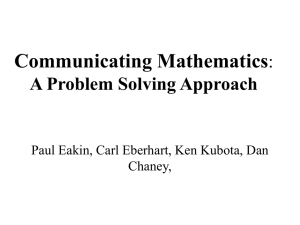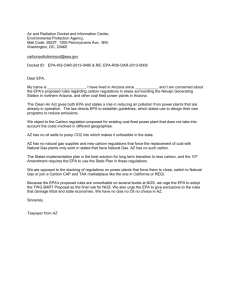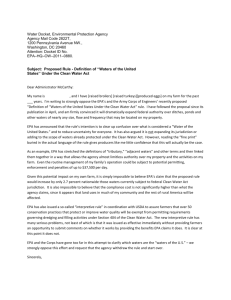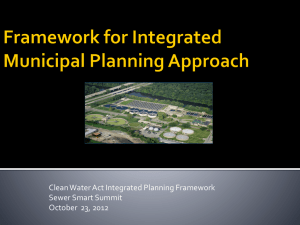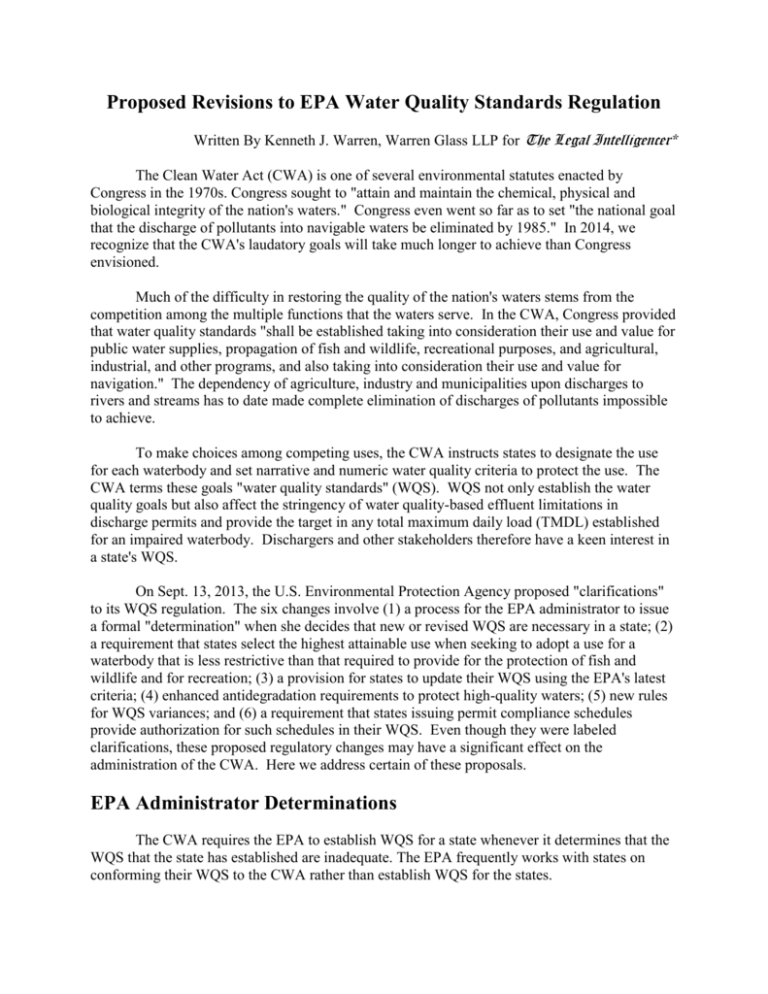
Proposed Revisions to EPA Water Quality Standards Regulation
Written By Kenneth J. Warren, Warren Glass LLP for The Legal Intelligencer*
The Clean Water Act (CWA) is one of several environmental statutes enacted by
Congress in the 1970s. Congress sought to "attain and maintain the chemical, physical and
biological integrity of the nation's waters." Congress even went so far as to set "the national goal
that the discharge of pollutants into navigable waters be eliminated by 1985." In 2014, we
recognize that the CWA's laudatory goals will take much longer to achieve than Congress
envisioned.
Much of the difficulty in restoring the quality of the nation's waters stems from the
competition among the multiple functions that the waters serve. In the CWA, Congress provided
that water quality standards "shall be established taking into consideration their use and value for
public water supplies, propagation of fish and wildlife, recreational purposes, and agricultural,
industrial, and other programs, and also taking into consideration their use and value for
navigation." The dependency of agriculture, industry and municipalities upon discharges to
rivers and streams has to date made complete elimination of discharges of pollutants impossible
to achieve.
To make choices among competing uses, the CWA instructs states to designate the use
for each waterbody and set narrative and numeric water quality criteria to protect the use. The
CWA terms these goals "water quality standards" (WQS). WQS not only establish the water
quality goals but also affect the stringency of water quality-based effluent limitations in
discharge permits and provide the target in any total maximum daily load (TMDL) established
for an impaired waterbody. Dischargers and other stakeholders therefore have a keen interest in
a state's WQS.
On Sept. 13, 2013, the U.S. Environmental Protection Agency proposed "clarifications"
to its WQS regulation. The six changes involve (1) a process for the EPA administrator to issue
a formal "determination" when she decides that new or revised WQS are necessary in a state; (2)
a requirement that states select the highest attainable use when seeking to adopt a use for a
waterbody that is less restrictive than that required to provide for the protection of fish and
wildlife and for recreation; (3) a provision for states to update their WQS using the EPA's latest
criteria; (4) enhanced antidegradation requirements to protect high-quality waters; (5) new rules
for WQS variances; and (6) a requirement that states issuing permit compliance schedules
provide authorization for such schedules in their WQS. Even though they were labeled
clarifications, these proposed regulatory changes may have a significant effect on the
administration of the CWA. Here we address certain of these proposals.
EPA Administrator Determinations
The CWA requires the EPA to establish WQS for a state whenever it determines that the
WQS that the state has established are inadequate. The EPA frequently works with states on
conforming their WQS to the CWA rather than establish WQS for the states.
The EPA proposes to add a provision to the WQS regulation stating that to trigger EPA's
obligations under CWA Section 303(c)(4)(B), a determination must be signed by the
administrator and expressly provide that it is a determination under CWA Section 303(c)(4)(B).
Nongovernmental organizations (NGOs) strongly oppose this change, noting that "26 states have
no nutrient criteria at all after 15 years of 'feedback,'" and that the EPA has been ordered by one
district court to make a necessity determination in response to a duly submitted petition,
according to Earthjustice comments dated Jan. 2 (citing Gulf Restoration Network v. Jackson,
2013 U.S. Dist. LEXIS 134811 (E.D. La. 2013)).
States and regulated entities support the proposal, some asserting that the issuance of an
EPA necessity determination is a discretionary act that a court cannot compel the EPA to
perform. The Fifth Circuit will have an opportunity to evaluate the merits of that argument when
it reviews the Gulf Restoration Network decision, which the EPA has appealed.
Use Attainability Analysis
Another EPA proposal addresses one of the more contentious processes in the
administration of the CWA, the use attainability analysis (UAA). Section 101(a)(2) of the CWA
limits state discretion to select WQS by requiring WQS to provide for the protection and
propagation of fish and wildlife and for recreation (the so-called "fishable/swimmable" uses)
unless those uses are unattainable. In reviewing WQS, the EPA presumes that a waterbody can
presently or after restoration support these uses, unless a state demonstrates otherwise through a
UAA based on the factors in 40 C.F.R. § 131.10(g). The EPA now proposes to require a state
relying on a UAA to adopt new or revised WQS that do not protect the fishable/swimmable uses
to select the highest attainable use for the waterbody, i.e., the use category previously established
by the state that is closest to the aquatic life, wildlife or recreational use specified in Section
101(a)(2) and feasible to attain.
States and various business stakeholders oppose this requirement on the ground that it
unnecessarily infringes on state discretion to adopt uses and that it improperly presumes a
hierarchy of uses. States contend that under the CWA, selection of categories of uses is a state
prerogative. In contrast, NGOs would require states to adopt specific categories or subcategories
of designated uses to ensure that the most protective attainable use becomes the WQS. They
contend further that uses such as drinking water not listed in CWA Section 101(a)(2) also require
protection.
Antidegradation
The EPA also proposes to modify WQS regulatory provisions imposing antidegradation
requirements for high-quality waters. At present, lowering of water quality in these waters is
allowed only when "necessary to accommodate important economic or social development in the
area in which the waters are located."
The EPA's proposal would require each state to develop statewide methods for
implementing its antidegradation policy. These methods must ensure that a waterbody is not
excluded from the antidegradation program "solely because not all of the uses specified in CWA
§ 101(a)(2) are attained." The EPA's proposal encourages states to examine water quality on a
parameter-by-parameter basis and protect those parameters exhibiting high quality. The EPA
would alternatively allow a state to conduct its analysis on a waterbody-by-waterbody basis
provided that the state holistically (after considering all chemical, biological and physical
characteristics) determines whether the waterbody is of high quality. NGOs have asked the EPA
to remove the waterbody-by-waterbody option on the ground that protecting any parameter
cleaner than WQS is consistent with the goals of the CWA. States strongly support preserving
their discretion to elect either option, while New York has proposed yet a third alternative: a useby-use approach.
Before allowing a discharge that might lower water quality in high-quality waters, the
proposed rule would also require, in addition to the socioeconomic analysis described above, an
alternatives analysis examining whether any nondegrading or minimally degrading alternatives
are available. The proposal is unclear regarding whether a state may rely on an applicant to
prepare the alternatives analysis, exclude alternatives that are not cost-effective or decline to
perform any alternatives analysis when the effect of a new discharge is de minimis. States seek
to preserve their discretion and together with industry challenge the EPA's authority to prescribe
implementation methods. In contrast, NGOs would further limit state discretion by requiring the
state to select the least degrading alternative.
WQS Variances
A WQS variance establishes a temporary WQS when a state cannot attain one or more of
the uses specified in the CWA despite placing technology-based effluent limitations in permits.
Variances may be targeted to specific pollutants, permittee(s) or waterbodies. States employ
variances when they do not want to permanently downgrade the designated use.
The EPA's current WQS regulation references variances as a permissible state policy
affecting implementation of WQS, but provides no details on their terms. The EPA now
proposes a new provision, which is more aptly described as a comprehensive regulation than
merely as a "clarification," containing various elements for a WQS variance, including: numeric
criteria that could be attained with point source controls, pollutant minimization plans and
nonpoint source pollutant reductions; justification based on a UAA factor or the need to support
restoration activities such as dam removal or wetland or stream reconfiguration; and a specified
duration of up to 10 years, renewable based upon a showing that the actions required by the
variance were implemented but the use remains unattainable. The temporary WQS would apply
for purposes of setting permit limits and issuing water quality certifications while the underlying
permanent WQS would apply for other purposes such as establishing TMDLs.
Variances may be best suited for waterbodies impaired by persistent bioaccumulative
toxins such as mercury or PCBs that adsorb to sediments and may take decades to remediate.
Variances may provide one mechanism to accommodate long-term restoration needs without
permanently changing the use.
The variance proposal fails to address several issues, including (1) whether and how to
consider water quality improvements that are anticipated during the variance term when selecting
numeric criteria; (2) how numeric criteria can be established for the duration of the variance in
situations where the permanent criteria are narrative; (3) how to accommodate restorations that
will take more than 10 years to complete; (4) how to utilize a variance when nonpoint sources
resist or are unable to achieve necessary pollutant load reductions; (5) how to coordinate the term
of the variance with the term of the discharge permits relating to the waterbody; and (6) how to
accommodate a state issuing a variance in conjunction with the permitting process, not the WQS
process.
The difficulty of resolving these issues is compounded by the dramatically opposed views
of stakeholders. NGOs oppose variances, support the TMDL process to attain permanent WQS,
and would relegate dischargers needing more time to meet permit limits to compliance
schedules. Because compliance schedules typically cannot exceed one five-year permit cycle,
dischargers are likely to find this position untenable, particularly in situations where their
discharges are affected by stormwater that can be remediated only with long-term soil and/or
groundwater cleanup programs. Some commenters on the proposed rule also oppose the
variance program as exceeding the EPA's authority under the CWA (which contains no
provisions for variances, long-term restorations or direct EPA regulation of nonpoint sources)
and intruding on state prerogatives.
Effect on Administration of CWA
The EPA's "clarifications" to the WQS regulation may have a significant effect on the
administration of the CWA. The proposed provision that the EPA must designate its criticisms of
state WQS to be a "determination" before the EPA's obligation to promulgate WQS is triggered
may make it harder for NGOs to use those criticisms to compel the EPA to issue WQS. The
proposed requirement that states performing UAAs adopt the highest attainable use may
introduce controversy over what use is "highest." The proposed addition of implementation
provisions to the antidegradation program may trigger challenges to the EPA's authority. The
variance provisions are likewise likely to cause controversy by appearing too restrictive to
facilitate long-term restoration, or too liberal in allowing states to defer attaining the uses
specified in the CWA. In sum, while the EPA's efforts to clarify the WQS regulation are
commendable, the EPA still has work to do to develop an effective, clear regulation.
Kenneth J. Warren is a founding partner of Warren Glass and has been practicing
environmental law for more than 30 years. He is a former chair of the American Bar
Association's section of environment, energy and resources, where he led the section's 10,000
members. He can be reached at kwarren@warrenglasslaw.com.
Reprinted with permission from the February 14, 2014 edition of
The Legal Intelligencer©2014 ALM Media Properties, LLC. All rights reserved.
Further duplication without permission is prohibited.
For information, contact 877-257-3382, reprints@alm.com or visit www.almreprints.com.






